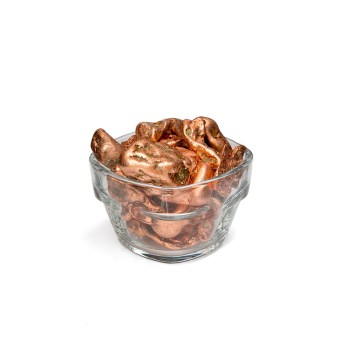Copper: Properties, Facts and Photos

What is Copper?
Copper is a reddish-brown chemical element. It was the first metal to be used by humans and the first to be smelted. Smelting is the process of extracting a metal from an ore by heating and melting.
The history of copper can be traced back at least 10,000 years. Imported by the Roman Empire from Cyprus, it was originally called 'aes cyprium', meaning 'metal of Cyprus.' The name was later shortened to 'cuprum.'
Copper is widely used in industry because it resists corrosion from air, moisture and seawater. It conducts electricity and heat and is used in pipes, wiring, heating and cooling applications and cooking pans.
Copper is often alloyed with other metals, including brass, which is copper and zinc. Bronze is copper, zinc, and tin, although other elements are often added.
Sterling silver is 92.5% pure silver and 7.5% copper. Even though copper is used as an alloy to strengthen silver, it's quite a soft metal. With it being ductile and malleable it hardens after being shaped and hammered. When heated, it can be softened again.
Although sterling silver tarnishes, pure silver does not. The tarnish comes from the copper.
Copper is an important trace element vital for the health of all living organisms. It can be found in a wide range of foods.

As well as a chemical compound, copper also occurs as a native element. Known as native copper, this means it occurs naturally in its pure metallic state without needing to be refined or processed.
Native elements are minerals formed from a single chemical element. Gold, sulphur and carbon are all native elements.
Native copper is typically found as irregularly shaped masses or dendritic crystals in copper-rich ore deposits.
The copper we're used to seeing is typically extracted from copper sulphide or oxide ores. This is done through a refining process that involves smelting and electrolysis to remove impurities and refine the copper to a high purity.
The main difference between native and the more familiar copper is purity and composition. Native copper is essentially pure copper. The variety used commercially is more likely to contain impurities. These are usually other metals, such as sulphur and oxygen.
An impurity is not the same as an inclusion.
Native copper can be used directly without any refining, whereas the other must be processed to remove impurities before it can be used.
In terms of appearance, native copper typically has a distinctive reddish-brown colour and metallic lustre. Because of impurities, manufactured copper tends to be a darker shade of brown.
By 8000 BC, native copper was being used instead of stone. Copper began being alloyed with tin to produce bronze in ancient Egypt around 3500 BC.
Most copper is extracted from ores. An ore is a rock or mineral that contains important elements and metals in sufficient quantities to make extraction worthwhile. However, the amount present is often very small.
Malachite is the oldest ore of copper. Today, chalcopyrite is the most abundant ore of copper.
The Keweenaw Peninsula of Michigan has one of the world's largest concentrations of native copper.
Prior to 1992, coins in the United Kingdom contained 97% copper. This meant the 2p coin contained 6.9 grams and the penny 3.45 grams. As market prices increased, the amount of copper used was reduced. Since 1992, 1p and 2p coins have been manufactured from steel with only a thin plate of copper. Since 2006, the coins have been worth more as scrap than their face value.
Article Pictures
The copper in our first photo is courtesy of Stan Celestian. The second photo, by Stone Mania, was taken in the Harvard Museum of Natural History, Massachusetts.
The last photo is chalcopyrite, courtesy of Ron Wolf.
Photos are clickable and redirect to the original image.
Pop-up photos: Sulphur - Courtesy of Géry Parent. Native copper, malachite - Courtesy of Stan Celestian.















